高中英语必修五课文及翻译
新课标高中英语必修5 课文翻译与要点 unit1
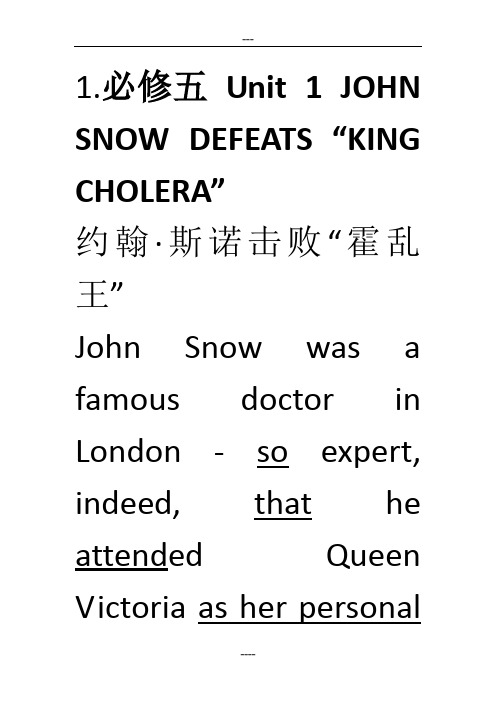
1.必修五Unit 1 JOHN SNOW DEFEATS “KING CHOLERA”约翰·斯诺击败“霍乱王”John Snow was a famous doctor in London - so expert, indeed, that he attended Queen Victoria as her personalphysician.约翰·斯诺是伦敦一位著名的医生——他的确医术精湛,因而成为照料维多利亚女王的私人医生。
But he became inspired when he thought about helping ordinary people exposed to cholera.但他一想到要帮助那些得了霍乱的普通百姓时,他就感到很振奋。
This was the deadly disease of its day.霍乱在当时是最致命的疾病,Neither its cause nor its cure was understood.人们既不知道它的病源,也不了解它的治疗方法。
So many thousands of terrified people diedevery time there was an outbreak.每次霍乱暴发时,就有大批惊恐的老百姓死去。
John Snow wanted to face the challenge and solve this problem.约翰·斯诺想面对这个挑战,解决这个问题。
He knew that cholera would never be controlled until itscause was found.他知道,在找到病源之前,霍乱疫情是无法控制的。
He became interested in two theories that possibly explained how cholera killed people.斯诺对霍乱致人死地的两种推测都很感兴趣。
【人教】高中英语必修5课文逐句翻译(Word版,15页】
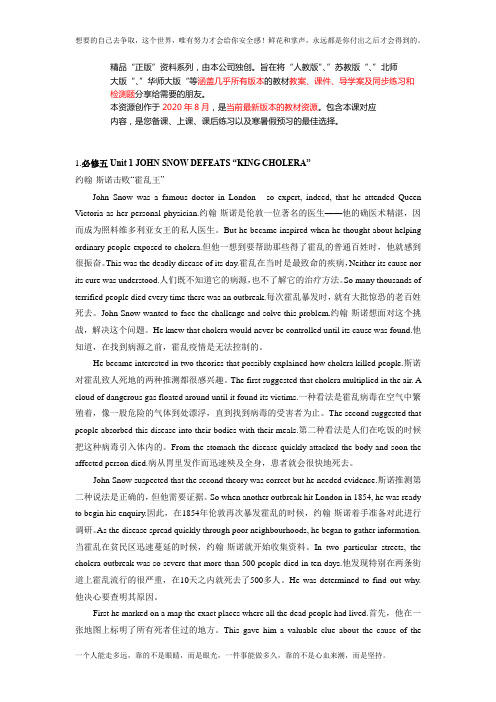
精品“正版”资料系列,由本公司独创。
旨在将“人教版”、”苏教版“、”北师大版“、”华师大版“等涵盖几乎所有版本的教材教案、课件、导学案及同步练习和检测题分享给需要的朋友。
本资源创作于2020年8月,是当前最新版本的教材资源。
包含本课对应内容,是您备课、上课、课后练习以及寒暑假预习的最佳选择。
1.必修五Unit 1 JOHN SNOW DEFEATS “KING CHOLERA”约翰·斯诺击败“霍乱王”John Snow was a famous doctor in London - so expert, indeed, that he attended Queen Victoria as her personal physician.约翰·斯诺是伦敦一位著名的医生——他的确医术精湛,因而成为照料维多利亚女王的私人医生。
But he became inspired when he thought about helping ordinary people exposed to cholera.但他一想到要帮助那些得了霍乱的普通百姓时,他就感到很振奋。
This was the deadly disease of its day.霍乱在当时是最致命的疾病,Neither its cause nor its cure was understood.人们既不知道它的病源,也不了解它的治疗方法。
So many thousands of terrified people died every time there was an outbreak.每次霍乱暴发时,就有大批惊恐的老百姓死去。
John Snow wanted to face the challenge and solve this problem.约翰·斯诺想面对这个挑战,解决这个问题。
He knew that cholera would never be controlled until its cause was found.他知道,在找到病源之前,霍乱疫情是无法控制的。
人教版高中英语必修五课文翻译
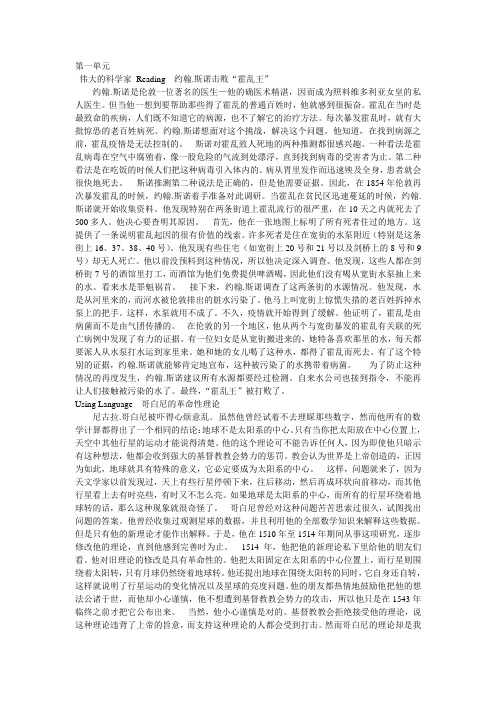
第一单元伟大的科学家Reading 约翰.斯诺击败“霍乱王”约翰.斯诺是伦敦一位著名的医生—他的确医术精湛,因而成为照料维多利亚女皇的私人医生。
但当他一想到要帮助那些得了霍乱的普通百姓时,他就感到很振奋。
霍乱在当时是最致命的疾病,人们既不知道它的病源,也不了解它的治疗方法。
每次暴发霍乱时,就有大批惊恐的老百姓病死。
约翰.斯诺想面对这个挑战,解决这个问题。
他知道,在找到病源之前,霍乱疫情是无法控制的。
斯诺对霍乱致人死地的两种推测都很感兴趣。
一种看法是霍乱病毒在空气中腐殖着,像一股危险的气流到处漂浮,直到找到病毒的受害者为止。
第二种看法是在吃饭的时候人们把这种病毒引入体内的。
病从胃里发作而迅速殃及全身,患者就会很快地死去。
斯诺推测第二种说法是正确的,但是他需要证据。
因此,在1854年伦敦再次暴发霍乱的时候,约翰.斯诺着手准备对此调研。
当霍乱在贫民区迅速蔓延的时候,约翰.斯诺就开始收集资料。
他发现特别在两条街道上霍乱流行的很严重,在10天之内就死去了500多人。
他决心要查明其原因。
首先,他在一张地图上标明了所有死者住过的地方。
这提供了一条说明霍乱起因的很有价值的线索。
许多死者是住在宽街的水泵附近(特别是这条街上16、37、38、40号)。
他发现有些住宅(如宽街上20号和21号以及剑桥上的8号和9号)却无人死亡。
他以前没预料到这种情况,所以他决定深入调查。
他发现,这些人都在剑桥街7号的酒馆里打工,而酒馆为他们免费提供啤酒喝,因此他们没有喝从宽街水泵抽上来的水。
看来水是罪魁祸首。
接下来,约翰.斯诺调查了这两条街的水源情况。
他发现,水是从河里来的,而河水被伦敦排出的脏水污染了。
他马上叫宽街上惊慌失措的老百姓拆掉水泵上的把手。
这样,水泵就用不成了。
不久,疫情就开始得到了缓解。
他证明了,霍乱是由病菌而不是由气团传播的。
在伦敦的另一个地区,他从两个与宽街暴发的霍乱有关联的死亡病例中发现了有力的证据。
有一位妇女是从宽街搬进来的,她特备喜欢那里的水,每天都要派人从水泵打水运到家里来。
高中英语必修五课文及翻译

高中英语必修五课文及翻译集团档案编码:[YTTR-YTPT28-YTNTL98-UYTYNN08]-必修 5Unit 2 The United KingdomReadingPUZZLES IN GEOGRAPHYPeople may wonder why different words are used to describe these four countries: England, Wales, Scotland and Northern Ireland. You can clarify this question if you study British history.First there was England. Wales was linked to it in the thirteenth century. Now when people refer to England you find Wales included as well. Next England and Wales were joined to Scotland in the seventeenth century and the name was changed to "Great Britain". Happily this was accomplished without conflict when King James of Scotland became King of England and Wales as well. Finally the English government tried in the early twentieth century to form the United Kingdom by getting Ireland connected in the same peaceful way. However, the southern part of Ireland was unwilling and broke away to form its own government. So only Northern Ireland joined with England, Wales and Scotland to become the United Kingdom and this was shown to the world in a new flag called the Union Jack.To their credit the four countries do work together in some areas (eg, the currency and international relations), but they still have very different institutions. For example, Northern Ireland, England and Scotland have different educational and legal systems as well as different football teams for competitions like the World Cup!England is the largest of the four countries, and for convenience it isdivided roughly into three zones. The zone nearest France is called the South of England, the middle zone is called the Midlands and the one nearest to Scotlandis known as the North. You find most of the population settled in the south, but most of the industrial cities in the Midlands and the North of England. Although, nationwide, these cities are not as large as those in China, they have world-famous football teams and some of them even have two! It is a pity that the industrial cities built in the nineteenth century do not attract visitors. For historical architecture you have to go to older but smaller towns built by the Romans. There you will find out more about British history and culture.The greatest historical treasure of all is London with its museums, art collections, theatres, parks and buildings. It is the centre of nationalgovernment and its administration. It has the oldest port built by the Romans in the first century AD, the oldest building begun by the Anglo-Saxons in the 1060s and the oldest castle constructed by later Norman rulers in 1066. There has been four sets of invaders of England. The first invaders, the Romans, left their towns and roads. The second, the Anglo-Saxons, left their language and their government. The third, the Vikings, influenced the vocabulary and place-names of the North of England, and the fourth, the Normans, left castles and introduced new words for food.If you look around the British countryside you will find evidence of all these invaders. You must keep your eyes open if you are going to make your trip to the United Kingdom enjoyable and worthwhile.人们可能会奇怪为什么用不同的词语来描述英格兰、威尔士、苏格兰和北爱尔兰这四个国家。
高中英语必修五课文与其翻译
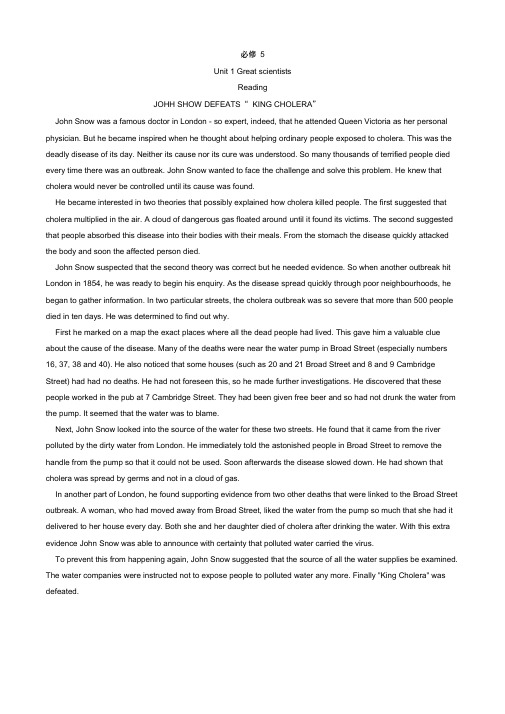
必修5Unit 1 Great scientistsReadingJOHH SHOW DEFEATS“ KING CHOLERA”John Snow was a famous doctor in London - so expert, indeed, that he attended Queen Victoria as her personal physician. But he became inspired when he thought about helping ordinary people exposed to cholera. This was the deadly disease of its day. Neither its cause nor its cure was understood. So many thousands of terrified people died every time there was an outbreak. John Snow wanted to face the challenge and solve this problem. He knew that cholera would never be controlled until its cause was found.He became interested in two theories that possibly explained how cholera killed people. The first suggested that cholera multiplied in the air. A cloud of dangerous gas floated around until it found its victims. The second suggested that people absorbed this disease into their bodies with their meals. From the stomach the disease quickly attacked the body and soon the affected person died.John Snow suspected that the second theory was correct but he needed evidence. So when another outbreak hit London in 1854, he was ready to begin his enquiry. As the disease spread quickly through poor neighbourhoods, he began to gather information. In two particular streets, the cholera outbreak was so severe that more than 500 people died in ten days. He was determined to find out why.First he marked on a map the exact places where all the dead people had lived. This gave him a valuable clue about the cause of the disease. Many of the deaths were near the water pump in Broad Street (especially numbers 16, 37, 38 and 40). He also noticed that some houses (such as 20 and 21 Broad Street and 8 and 9 Cambridge Street) had had no deaths. He had not foreseen this, so he made further investigations. He discovered that these people worked in the pub at 7 Cambridge Street. They had been given free beer and so had not drunk the water from the pump. It seemed that the water was to blame.Next, John Snow looked into the source of the water for these two streets. He found that it came from the river polluted by the dirty water from London. He immediately told the astonished people in Broad Street to remove the handle from the pump so that it could not be used. Soon afterwards the disease slowed down. He had shown that cholera was spread by germs and not in a cloud of gas.In another part of London, he found supporting evidence from two other deaths that were linked to the Broad Street outbreak. A woman, who had moved away from Broad Street, liked the water from the pump so much that she had it delivered to her house every day. Both she and her daughter died of cholera after drinking the water. With this extra evidence John Snow was able to announce with certainty that polluted water carried the virus.To prevent this from happening again, John Snow suggested that the source of all the water supplies be examined. The water companies were instructed not to expose people to polluted water any more. Finally "King Cholera" was defeated.Using LanguageCOPERNICUS' REVOLUTION RRY THEORYNicolaus Copernicus was frightened and his mind was confused. Although he had tried to ignore them, all his mathematical calculations led to the same conclusion: that the earth was not the centre of the solar system. Only if you put the sun there did the movements of the other planets in the sky make sense. Yet he could not tell anyone about his theory as the powerful Christian Church would have punished him for even suggesting such an idea. They believed God had made the world and for that reason the earth was special and must be the centre of the solar system.The problem arose because astronomers had noticed that some planets in the sky seemed to stop, move backward and then go forward in a loop. Others appeared brighter at times and less bright at others. This was very strange if the earth was the centre of the solar system and all planets went round it.Copernicus had thought long and hard about these problems and tried to find an answer. He had collected observations of the stars and used all his mathematical knowledge to explain them. But only his new theory could do that. So between 1510 and 1514 he worked on it, gradually improving his theory until he felt it was complete.In 1514 he showed it privately to his friends. The changes he made to the old theory were revolutionary. He placed a fixed sun at the centre of the solar system with the planets going round it and only the moon still going round the earth. He also suggested that the earth was spinning as it went round the sun and this explained changes in the movement of the planets and in the brightness of the stars. His friends were enthusiastic and encouraged him to publish his ideas, but Copernicus was cautious. He did not want to be attacked by the Christian Church, so he only published it as he lay dying in 1543.Certainly he was right to be careful. The Christian Church rejected his theory, saying it was against God's idea and people who supported it would be attacked. Yet Copernicus' theory is now the basis on which all our ideas of the universe are built. His theory replaced the Christian idea of gravity, which said things fell to earth because God created the earth as the centre of the universe. Copernicus showed this was obviously wrong. Now people can see that there is a direct link between his theory and the work of Isaac Newton, Albert Einstein and Stephen Hawking.Unit 2 The United Kingdom Reading PUZZLES IN GEOGRAPHY People may wonder why different words are used to describe these four countries: England, Wales, Scotland and Northern Ireland. You can clarify this question if you study British history.First there was England. Wales was linked to it in the thirteenth century. Now when people refer to England you find Wales included as well. Next England and Wales were joined to Scotland in the seventeenth century and the name was changed to "Great Britain". Happily this was accomplished without conflict when King James of Scotland became King of England and Wales as well. Finally the English government tried in the early twentieth century to form the United Kingdom by getting Ireland connected in the same peaceful way. However, the southern part of Ireland was unwilling and broke away to form its own government. So only Northern Ireland joined with England, Wales and Scotland to become the United Kingdom and this was shown to the world in a new flag called the Union Jack.To their credit the four countries do work together in some areas (eg, the currency and international relations), but they still have very different institutions. For example, Northern Ireland, England and Scotland have different educational and legal systems as well as different football teams for competitions like the World Cup!England is the largest of the four countries, and for convenience it is divided roughly into three zones. The zone nearest France is called the South of England, the middle zone is called the Midlands and the one nearest to Scotland is known as the North. You find most of the population settled in the south, but most of the industrial cities in the Midlands and the North of England. Although, nationwide, these cities are not as large as those in China, they have world-famous football teams and some of them even have two! It is a pity that the industrial cities built in the nineteenth century do not attract visitors. For historical architecture you have to go to older but smaller towns built by the Romans. There you will find out more about British history and culture.The greatest historical treasure of all is London with its museums, art collections, theatres, parks and buildings. It is the centre of national government and its administration. It has the oldest port built by the Romans in the first century AD, the oldest building begun by the Anglo-Saxons in the 1060s and the oldest castle constructed by later Norman rulers in 1066. There has been four sets of invaders of England. The first invaders, the Romans, left their towns and roads. The second, the Anglo-Saxons, left their language and their government. The third, the Vikings, influenced the vocabulary and place-names of the North of England, and the fourth, the Normans, left castles and introduced new words for food.If you look around the British countryside you will find evidence of all these invaders. You must keep your eyes open if you are going to make your trip to the United Kingdom enjoyable and worthwhile.Using LanguageSIGHTSEEING IN LONDONWorried about the time available, Zhang Pingyu had made a list of the sites she wanted to see in London. Her first delight was going to the Tower. It was built long ago by the Norman invaders of AD 1066. Fancy! This solid stone, square tower had remained standing for one thousand years.Although the buildings had expanded around it, it remained part of a royal palace and prison combined. To her great surprise, Zhang Pingyu found the Queen's jewels guarded by special royal soldiers who, on special occasions, still wore the four-hundred-year-old uniform of the time of Queen Elizabeth I.There followed St Paul's Cathedral built after the terrible fire of London in 1666. It looked splendid when first built! Westminster Abbey, too, was very interesting. It contained statues in memory of dead poets and writers, such as Shakespeare. Then just as she came out of the abbey, Pingyu heard the famous sound of the clock, Big Ben, ringing out the hour. She finished the day by looking at the outside of Buckingham Palace, the Queen's house in London. Oh, she had so much to tell her friends!The second day the girl visited Greenwich and saw its old ships and famous clock that sets the world time. What interested her most was the longitude line. It is an imaginary line dividing the eastern and western halves of the world and is very useful for navigation. It passes through Greenwich, so Pingyu had a photo taken standing on either side of the line.The last day she visited Karl Marx's statue in Highgate Cemetery. It seemed strange that the man who had developed communism should have lived and died in London. Not only that, but he had worked in the famous reading room of the Library of the British Museum. Sadly the library had moved from its original place into another building and the old reading room was gone. But she was thrilled by so many wonderful treasures from different cultures displayed in the museum. When she saw many visitors enjoying looking at the beautiful old Chinese pots and other objects on show, she felt very proud of her country.The next day Pingyu was leaving London for Windsor Castle. "Perhaps I will see the Queen?" she wondered as she fell asleep.Unit 3 Life in the futureReadingFIRST IMPRESSIONSSpacemall: liqiang299A@ 15/11/3008 (Earthtime)Dear Mum and Dad,I still cannot believe that I am taking up this prize that I won last year. I have to remind myself constantly that I am really in AD 3008. Worried about the journey, I was unsettled for the first few days. As a result, I suffered from “ Time lag ” . This is similar to the “ jet lag ” you get from flyieneg,pbguettittinsgeeflamsshyboauckks from your previous time period. So I was very nervous and uncertain at first. However, my friend and guide, Wang Ping, was very understanding and gave me some green tablets which helped a lot. Well-known for their expertise, his parents' company, called "Future Tours", transported me safely into the future in a time capsule.I can still remember the moment when the space stewardess called us all to the capsule and we climbed in through a small opening. The seats were comfortable and after a calming drink, we felt sleepy and closed our eyes. The capsule began swinging gently sideways as we lay relaxed and dreaming. A few minutes later, the journey was completed and we had arrived. I was still on the earth but one thousand years in the future. What would I find?At first my new surroundings were difficult to tolerate. The air seemed thin, as though its combination of gases had little oxygen left. Hit by a lack of fresh air, my head ached. Just as I tried to make the necessary adjustment to this new situation, Wang Ping appeared. "Put on this mask," he advised. "It'll make you feel much better." He handed it to me and immediately hurried me through to a small room nearby for a rest. I felt better in no time. Soon I was back on my feet again and following him to collect a hovering carriage driven by computer. These carriages float above the ground and by bending or pressing down in your seat, you can move swiftly. Wang Ping fastened my safety belt and showed me how to use it. Soon I could fly as fast as him. However, I lost sight of Wang Ping when we reached what looked like a large market because of too many carriages flying by in all directions. He was swept up into the centre of them. Just at that moment I had a "time lag" flashback and saw the area again as it had been in the year AD 2008. I realized that I had been transported into the future of what was still my hometown! Then I caught sight of Wang Ping again and flew after him.Arriving at a strange-looking house, he showed me into a large, bright clean room. It had a green wall, a brown floor and soft lighting. Suddenly the wall moved - it was made of trees! I found later that their leaves provided the room with much-needed oxygen. Then Wang Ping flashed a switch on a computer screen, and a table and some chairs rose from under the floor as if by magic. "Why not sit down and eat a little?" he said. "You may find this difficult as it is your first time travel trip. Just relax, since there is nothing planned on the timetable today. Tomorrow you'll be ready for some visits." Having said this, he spread some food on the table, and produced a bed from the floor. After he left, I had a brief meal and a hot bath. Exhausted, I slid into bed and fell fast asleep.More news later from your loving son,Li QiangUsing LanguageI HA VE SEEN AMAZING THINGSMy first visit was to a space station considered the most modem in space. Described as an enormous round plate, it spins slowly inspace to imitate the pull of the earth's gravity. Inside was an exhibition of the most up-to-date inventions of the 31 st century. A guide (G) showed us around along a moveable path.G: Good morning to all our visitors from 2008. First we're going to examine one of the latest forms of communication among our space citizens. No more typists working on a typewriter or computer! No more postage or postcodes! Messages can now be sent using a "thoughtpad". You place the metal band over your head, clear your mind, press the sending button, think your message and the next instant it's sent. It's stored on the "thoughtpad" of the receiver. It's quick, efficient and environmentally friendly. The only limitation is if the user does not think his or her message clearly, an unclear message may be sent. But we cannot blame the tools for the faults of the user, can we?During the explanation I looked at the pair of small objects called "thoughtpads" on a table. They just looked like metal ribbons. So ordinary but so powerful! While I was observing them, the path moved us on.G: And now ladies and gentlemen, we are in the "environment area". People used to collect waste in dustbins. Then the rubbish was sent to be buried or burned, am I fight? (We nodded.) Well, now there's a system where the waste is disposed of using the principles of ecology. A giant machine, always greedy for more, swallows all the waste available. The rubbish is turned into several grades of useful material, such as "fertilizer" for the fields and "soil" for deserts. Nothing is wasted, andeverything, even plastic bags, is recycled. A great idea, isn't' it?I stared at the moving model of the waste machine, absorbed by its efficiency. But again we moved on.G: Our third stop shows the changes that have happened to work practices. Manufacturing no longer takes place on the earth but on space stations like this one. A group of engineers programme robots to perform tasks in space. The robots produce goods such as drugs, clothes, furniture, hovering carriages, etc. There is no waste, no pollution and no environmentaldamage! However, the companies have to train their representatives to live and work in space settlements. They have to monitor the robots and the production. When the goods are ready they're transported by industrial spaceship back to earth. My mind began to wander. What job would I do? My motivation increased as I thought of the wonderful world of the future.Unit 4 Making the newsReadingMY FIRST WORK ASSIGNMENT"Unforgettable", says new journalistNever will Zhou Yang (ZY) forget his first assignment at the office of a popular English newspaper. His discussion with his new boss, Hu Xin (HX), was to strongly influence his life as a journalist.HX: Welcome. We're delighted you're coming to work with us. Your first job here will be an assistant journalist. Do you have any questions?ZY: Can I go out on a story immediately?HX: (laughing) That' s admirable, but I' m afraid it would be unusual ! Wait till you' re more experienced. First we'll put you as an assistant to an experienced journalist. Later you can cover a story and submit the articleyourself.ZY: Wonderful. What do I need to take with me? I already have a notebook and camera.HX: No need for a camera. You'll have a professional photographer with you to take photographs. You'll find your colleagues very eager to assist you, so you may be able to concentrate on photography later if you' reinterested.ZY: Thank you. Not only am I interested in photography, but I took an amateur course at university to update my skills.HX: Good.ZY: What do I need to remember when I go out to cover a story?HX: You need to be curious. Only if you ask many different questions will you acquire all the information you need to know. We say a good journalist must have a good "nose" for a story. That means you must be able toassess when people are not telling the whole troth and then try to discover it. They must use research toinform themselves of the missing parts of the story.ZY: What should I keep in mind?HX: Here comes my list of dos and don'ts: don't miss your deadline, don't be rode, don't talk too much, but make sure you listen to the interviewee carefully.ZY: Why is listening so important?HX: Well, you have to listen for detailed facts. Meanwhile you have to prepare the next question depending on what the person says.ZY: But how can I listen carefully while taking notes?HX: This is a trick of the trade, If the interviewee agrees, you can use a recorder to get the facts straight. It's also useful if a person wants to challenge you. You have the evidence to support your story.ZY: I see! Have you ever had a case where someone accused your journalists of getting the wrong end of the stick?HX: Yes, but it was a long time ago. This is how the story goes. A footballer was accused of taking money for deliberately not scoring goals so as to let the other team win. We went to interview him. He denied takingmoney but we were sceptical. So we arranged an interview between the footballer and the man supposed tobribe him. When we saw them together we guessed from the footballer's body language that he was nottelling the truth. So we wrote an article suggesting he was guilty. It was a dilemma because the footballercould have demanded damages if we were wrong. He tried to stop us publishing it but later we were provedright.ZY:Wow! That was a real "scoop". I'm looking forward to my first assignment now. Perhaps I'll get a scoop too!HX: Perhaps you will. You never know.Using LanguageGETTING THE "SCOOP""Quick," said the editor. "Get that story ready. We need it in this edition to be ahead of the other newspapers.This is a scoop." Zhou Yang had just come back into the office after an interview with a famous film star. "Did he really do that?" asked someone from the International News Department. "Yes, I' m afraid he did," Zhou Yanganswered. He set to work.His first task was to write his story, but he had to do it carefully. Although he realized the man had been lying, Zhou Yang knew he must not accuse him directly. He would have to be accurate. Concise too! He knew how to do that. Months of training had taught him to write with no wasted words or phrases. He sat down at his computer and began to work.The first person who saw his article was a senior editor from his department. He checked the evidence, read the article and passed it on to the copy-editor. She began to edit the piece and design the main headline and smaller heading. “ This will look very good on the page, ” she said. "Where is a good picture of this man?" Then as the article was going to be written in English Zhou Yang also took a copy to the native speaker employed by the newspaper to polish the style. She was also very happy with Zhou Yang's story. "You are really able to write a good front page article," she said. Zhou Yang smiled with happiness. Last of all, the chief editor read it and approved it. "Well done," he said to Zhou Yang. "But please show me your evidence so we're sure we've got our facts straight. ” “ I ' ll bring it to you immediately," said Zhou Yang excitedly.The news desk editor took the story and began to work on all the stories and photos until all the pages were set.All the information was then ready to be processed into film negatives. This was the first stage of the printing process. They needed four negatives, as several colours were going to be used on the story. Each of the main colours had one negative sheet and when they were combined they made a coloured page for the newspaper. After one last check the page was ready to be printed. Zhou Yang waited excitedly for the first copies to be ready. "Wait 611 tonight," his friend whispered. "I expect there will be something about this on the television news. A real scoop!"Unit 5 First aidReadingFIRST AID FOR BURNSThe skin is an essential part of your body and its largest organ. You have three layers of skin which act as a barrier against disease, poisons and the sun's harmful rays. The functions of your skin are also very complex: it keeps you warm or cool; it prevents your body from losing too much water; it is where you feel cold, heat or pain and it gives you your sense of touch. So as you can imagine, if your skin gets burned it can be very serious. First aid is a very important first step in the treatment of bums. Causes of burnsYou can get burned by a variety of things: hot liquids, steam, fire, radiation (by being close to high heat or fire, etc), the sun, electricity or chemicals.Types of burnsThere are three types of burns. Burns are called first, second or third degree burns, depending on which layers of the skin are burned.◎ First degree burns These affect only the top layer of the skin. These burns are not serious and should feel better within a day or two. Examples include mild sunburn and burns caused by touching a hot pan,stove or iron for a mordent.◎ Second degree burns These affect both the top and the second layer of the skin. These bums are serious and take a few weeks to heal. Examples include severe sunburn and bums caused by hot liquids.◎ Third degree burns These affect all three layers of the skin and any tissue and organs under the skin. Examples include burns caused by electric shocks, burning clothes, or severe petrol fires. These burns cause very severe injuries and the victim must go to hospital at once.Characteristics of burnsFirst degree burns◎ dry, red and mildly swollen◎ mildly painful◎ turn white when pressedSecond degree burns◎ rough, red and swollen◎ blisters◎ watery surface◎ extremely painfulThird degree burns◎ black and white and charred◎ swollen; often tissue under them can be seen◎ little or no pain if nerves are damaged; may be pain around edge of injured area.First aid treatment 1 Remove clothing using scissors if necessary unless it is stuck to the burn. Take off other clothing and jewellery near the burn.2 Cool burns immediately with cool but not icy water. It is best to place burns under gently running water forabout 10 minutes. (The cool water stops the burning process, prevents the pain becoming unbearable and reduces swelling.) Do not put cold water on third degree burns.3 For first degree burns, place cool, clean, wet cloths on them until the pain is not so bad. For second degreeburns, keep cloths cool by putting them back in a basin of cold water, squeezing them out and placing them on the burned area over and over again for about an hour until the pain is not so bad.4 Dry the burned area gently. Do not rob, as this may break any blisters and the wound may get infected.5 Cover the burned area with a dry, clean bandage that will not stick to the skin. Hold the bandage in place with tape. Never put butter, oil or ointment on bums as they keep the heat in the wounds and may cause infection.6 If bums are on arms or legs, keep them higher than the heart, if possible. If bums are on the face, the victim should sit up.7 If the injuries are second or third degree bums, it is vital to get the victim to the doctor or hospital at once.Using LanguageHEROIC TEENAGER RECEIVES AW ARDSeventeen-year-old teenager, John Janson, was honoured at the Lifesaver Awards last night in Rivertown for giving lifesaving first aid on his neighbour after a shocking knife attack.John was presented with his award at a ceremony which recognized the bravery of ten people who had saved the life of another.John was studying in his room when he heard screaming. When he and his father rushed outside, a man ran from the scene. They discovered that Anne Slade, mother of three, had been stabbed repeatedly with a knife. She was lying in her front garden bleeding very heavily. Her hands had almost been cut off.It was John's quick action and knowledge of first aid that saved Ms Slade's life. He immediately asked a number of nearby people for bandages, but when nobody could put their hands on any, his father got some tea towels and tape from their house. John used these to treat the most severe injuries to Ms Slade's hands. He slowed the bleeding by applying pressure to the wounds until the police and ambulance arrived."I'm proud of what I did but I was just doing what I'd been taught," John said.John had taken part in the Young Lifesaver Scheme at his high school. When congratulating John, Mr Alan Southerton, Director of the Young Lifesaver Scheme said, "There is no doubt that John's quick thinking and the first aid skills he learned at school saved Ms Slade's life. It shows that a knowledge of first aid can make a real difference."Before receiving their awards last night, John and the nine other Life Savers attended a special reception yesterday hosted by the Prime Minister.Translation ofttw reading texts课文译文第一单元伟大的科学家READING的输•斯诺击欢•專礼王-约翰斯诺址伦敦付斤名的医4——他的确快术怖M•因向成为照料燈#利亚女*的私人决生•但 r他w«n i> \ IKALW ftifinn.时.他秋憋到很按荷•科机任時时她帰纹侖的咲辆.人们既《WC的机!•也價亡的治疗力滋・帀次■发WAlnj. 林 Mftm的“诃:編死.约輪斯诺想闵对这个桃乩■决这个剛他知ML mi阑澹2他・「.址情址无法悴制的・听诺忤肌致人死堆的曲种推测晶很膿兴趣.一种行法圧循乱嘀梅住空"(屮繁殖忆偸一股危险的久体到处次沢"列找何病恋的哽寓忙为止.第一种(iffMi吃饭的时候人们把这种敬帘引人体内的.蔽从IV也发作iWiBiE欣及金专•处打血介很快地*EA.•HSttMm 种说法黑正确的・0 H他flfBfiEW.因此.隹]«4年IfettMAMSM的时俟• hlfl 忻诺『匸怡备对此连行调研.当用乩4贫民区迅速卷延的时趴约翰斯诺沈开冶收処衣札也发规特别企两条街也MR乱廉杼得很严币.在10天Z内就死去了500#人•他决心要竇崛其原闪.n先.他在・覧地用I休明厂"比/ 的地方.这枫供了«9豪有价值的线诡iT步死甘見住在霓畅的水*用近«恃別堆这茨街上血37. M. 40 M).他发现侖些住宅(如寬怖上20号和2i号以■祐上的8号和9号)却无人死t •他.•你*別这冲惰况・町乂他决H深人■査.« «.这此人都4制桥街7U的泊h•伸打1八rfnmf为他们免龄提佻岬酒对•因此也们没有喝从電街水泵捕上来的水.薪*水ttwwwfr. ・&卜* 约詡・的*滅情兀•他发现.水址从阿喂*:的.向河爪敲伦软用出的駅出河心几他卩上仙宽很上惊慢夷屈也rr【姓折摊水泵的把『・• IUY・水至就川不成r.仁久.茨情就开妬得到缓紀他证明C东乱址由病曲而不是由气团传捲的.彳伦41的穷fMB •他从曲个(「」"、恥的死广無例中发現了有力的证握•有-•位扫攵址从宪oiWHi米的.她待别AWU叩的水•毎天都姿源人从水采打水运到家坐来.迪和憶的攵儿啪r这仲水.Wfl门I:乩向吃儿h广这个納别的iiLlK.约翰斷诺就能移肾遛地”旅这忡被石染r的木携带/i伽.力m止这种和况的再度发的翰斯诟建议所冇水譚祁要经过枚亂n*水公m也接戸怖今.不他山比人訂按融械刃柴的水丁.仗终.M lR«LiE- ttd/ttfe127。
英语必修5课文翻译

英语必修5课文翻译2篇【课文翻译1】课文一:《The Great Barrier Reef》澳大利亚的大堡礁是世界上最大的珊瑚礁系统,也是世界七大自然奇迹之一。
它横跨约344,400平方公里的面积,位于澳大利亚东北部的海域,是一个由上百个珊瑚岛和珊瑚礁组成的海洋生态系统。
大堡礁面临着许多环境威胁,尤其是全球变暖和海洋酸化对珊瑚的胁迫。
全球变暖导致海洋温度升高,珊瑚容易发生珊瑚白化,这是由于珊瑚体内共生的微生物受损而导致的。
海洋酸化则使珊瑚的骨骼变脆,难以生存。
此外,过度捕捞、海洋污染和旅游活动等也对大堡礁的生态环境造成了威胁。
为了保护大堡礁,澳大利亚政府采取了多项措施。
首先,他们实施了严格的法规和管理制度,限制了捕鱼和捕捞活动。
其次,他们设立了保护区,限制了旅游活动的规模和频率,以减少对珊瑚的冲击。
另外,政府还投资大量资金用于研究和科学监测工作,以便更好地了解和应对大堡礁面临的挑战。
大堡礁是一个宝贵的自然资源,不仅对澳大利亚来说具有巨大的经济价值,也对世界上其他地区的生态平衡和生物多样性至关重要。
我们每个人都应该意识到保护大堡礁的重要性,并采取行动,减少对其环境的破坏。
【课文翻译2】课文二:《The Water of Life》《生命之水》这篇课文讲述了水在我们生活中的重要性。
水是人类生命中最必需的资源,没有水就无法生存。
它既是人体的重要组成部分,也是支撑生态系统和农业生产的基础。
然而,正如课文中所提到的,全球范围内正在出现水资源短缺的问题。
水资源短缺的原因多种多样。
首先,人口的持续增长导致了对水的需求增加。
许多发展中国家面临着人口快速增长和供水设施不足的困境。
其次,气候变化也使得水资源变得更加紧缺。
干旱、洪水和极端天气事件的增多对水资源供应链造成了很大的压力。
此外,水的污染也导致可用水资源减少。
为了解决水资源短缺的问题,我们需要采取一系列措施。
首先是节约用水。
每个人都可以从小事做起,比如关掉水龙头、修复漏水管道等。
高中英语必修5课文逐句翻译
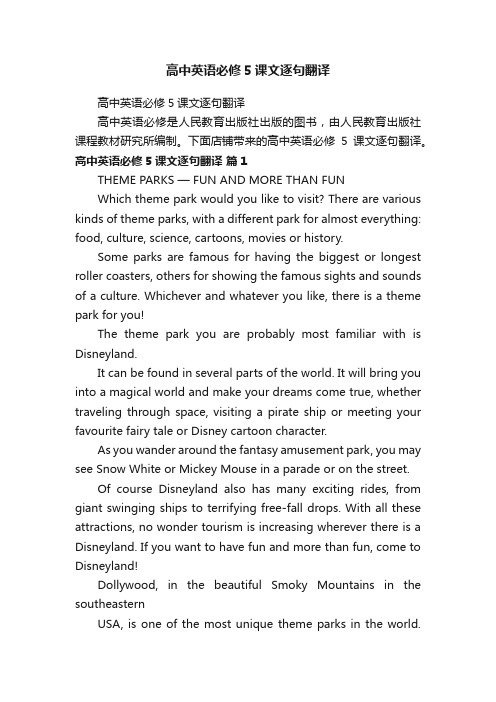
高中英语必修5课文逐句翻译高中英语必修5课文逐句翻译高中英语必修是人民教育出版社出版的图书,由人民教育出版社课程教材研究所编制。
下面店铺带来的高中英语必修5课文逐句翻译。
高中英语必修5课文逐句翻译篇1THEME PARKS — FUN AND MORE THAN FUNWhich theme park would you like to visit? There are various kinds of theme parks, with a different park for almost everything: food, culture, science, cartoons, movies or history.Some parks are famous for having the biggest or longest roller coasters, others for showing the famous sights and sounds of a culture. Whichever and whatever you like, there is a theme park for you!The theme park you are probably most familiar with is Disneyland.It can be found in several parts of the world. It will bring you into a magical world and make your dreams come true, whether traveling through space, visiting a pirate ship or meeting your favourite fairy tale or Disney cartoon character.As you wander around the fantasy amusement park, you may see Snow White or Mickey Mouse in a parade or on the street.Of course Disneyland also has many exciting rides, from giant swinging ships to terrifying free-fall drops. With all these attractions, no wonder tourism is increasing wherever there is a Disneyland. If you want to have fun and more than fun, come to Disneyland!Dollywood, in the beautiful Smoky Mountains in the southeasternUSA, is one of the most unique theme parks in the world.Dollywood shows and celebrates America's traditional southeastern culture. Although Dollywood has rides, the park's main attraction is its culture. Famous country music groups perform there all year in indoor and outdoor theatres.People come from all over America to see carpenters and other craftsmen make wood, glass and iron objects in the old-fashioned way. Visit the candy shop to try the same kind of candy that American southerners made 150 years ago, or take a ride on the only steam- engine train still working in the southeast USA. You can even see beautiful bald eagles in the world's largest bald eagle preserve.And for those who like rides, Dollywood has one of the best old wooden roller coasters, Thunderhead. It is world-famous for having the most length in the smallest space. Come to Dollywood to have fun learning all about America's historical southeastern culture!If you want to experience the ancient days and great deeds of English knights and ladies, princes and queens, then England's Camelot Park is the place for you. Every area of the park is modelled after life in the days of King Arthur and the Knights of the Round Table. In one place, you can watch magic shows with Merlin the Wizard. If you want to see fighting with swords or on horseback, then the jousting area is a good place to visit.If you do well there, King Arthur may choose you to fight in the big jousting tournament. Do you like animals? Then visit the farm area, and learn how people in ancient England ran their farms and took care of their animals. To enter a world of fantasy about ancient England, come to Camelot Park!主题公园——是娱乐,又不仅仅是娱乐你想要参观哪一个主题公园呢?(世界上)有各种各样的主题公园,不同的公园有不同的主题,但几乎囊括了一切:食物、文化、科学、卡通、电影及历史。
必修五课文原文及翻译
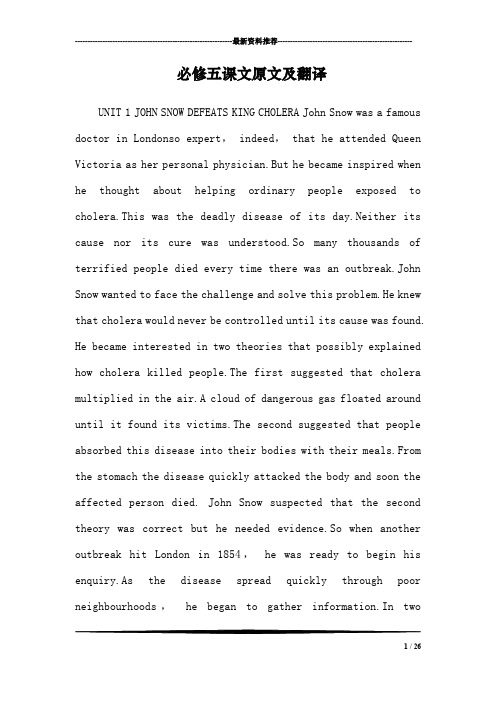
---------------------------------------------------------------最新资料推荐------------------------------------------------------必修五课文原文及翻译UNIT 1 JOHN SNOW DEFEATS KING CHOLERA John Snow was a famous doctor in Londonso expert, indeed, that he attended Queen Victoria as her personal physician.But he became inspired when he thought about helping ordinary people exposed to cholera.This was the deadly disease of its day.Neither its cause nor its cure was understood.So many thousands of terrified people died every time there was an outbreak.John Snow wanted to face the challenge and solve this problem.He knew that cholera would never be controlled until its cause was found. He became interested in two theories that possibly explained how cholera killed people.The first suggested that cholera multiplied in the air.A cloud of dangerous gas floated around until it found its victims.The second suggested that people absorbed this disease into their bodies with their meals.From the stomach the disease quickly attacked the body and soon the affected person died. John Snow suspected that the second theory was correct but he needed evidence.So when another outbreak hit London in 1854,he was ready to begin his enquiry.As the disease spread quickly through poor neighbourhoods,he began to gather information.In two1 / 26particular streets,the cholera outbreak was so severe that more than 500 people died in ten days.He was determined to find out why. First he marked on a map the exact places where all the dead people had lived.This gave him a valuable clue about the cause of the disease.Many of the deaths were near the water pump in Broad Street(especially numbers 16,37,38 and 40). He also noticed that some houses(such as 20 and 21 Broad Street and 8 and 9 Cambridge Street) had had no deaths.He had not foreseen this, so he made further investigations.He discovered that these people worked in the pub at 7 Cambridge Street.They had been given free beer and so had not drunk the water from the pump.It seemed that the water was to blame. Next, John Snow looked into the source of the water for these two streets.He found that it came from the river polluted by the dirty water from London.He immediately told the astonished people in Broad Street to remove the handle from the pump so that it could not be used.Soon afterwards the disease slowed down.He had shown that cholera was spread by germs and not in a cloud of gas. In another part of London, he found supporting evidence from two other deaths that were linked to the Broad Street outbreak.A woman, who had moved away from Broad Street, liked the water from the pump so much that she had it delivered to her house---------------------------------------------------------------最新资料推荐------------------------------------------------------ every day.Both she and her daughter died of cholera after drinking the water.With this extra evidence John Snow was able to announce with certainty that polluted water carried the virus. To prevent this from happening again,John Snow suggested that the source of all the water supplies be examined.The water companies were instructed not to expose people to polluted water any more.Finally King Cholera was defeated. 约翰斯诺战胜霍乱王约翰斯诺是伦敦一位著名的医生他的确医术精湛,以至于成了照料维多利亚女王的私人医生。
必修5-人教版高中英语课文原文和翻译
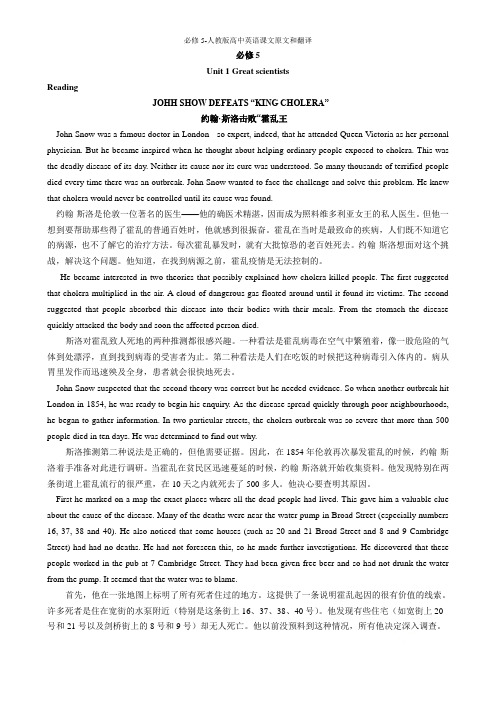
必修5Unit 1 Great scientistsReadingJOHH SHOW DEFEATS “KING CHOLERA”约翰·斯洛击败“霍乱王John Snow was a famous doctor in London - so expert, indeed, that he attended Queen Victoria as her personal physician. But he became inspired when he thought about helping ordinary people exposed to cholera. This was the deadly disease of its day. Neither its cause nor its cure was understood. So many thousands of terrified people died every time there was an outbreak. John Snow wanted to face the challenge and solve this problem. He knew that cholera would never be controlled until its cause was found.约翰·斯洛是伦敦一位著名的医生——他的确医术精湛,因而成为照料维多利亚女王的私人医生。
但他一想到要帮助那些得了霍乱的普通百姓时,他就感到很振奋。
霍乱在当时是最致命的疾病,人们既不知道它的病源,也不了解它的治疗方法。
每次霍乱暴发时,就有大批惊恐的老百姓死去。
约翰·斯洛想面对这个挑战,解决这个问题。
他知道,在找到病源之前,霍乱疫情是无法控制的。
He became interested in two theories that possibly explained how cholera killed people. The first suggested that cholera multiplied in the air. A cloud of dangerous gas floated around until it found its victims. The second suggested that people absorbed this disease into their bodies with their meals. From the stomach the disease quickly attacked the body and soon the affected person died.斯洛对霍乱致人死地的两种推测都很感兴趣。
高二英语必修五课文翻译
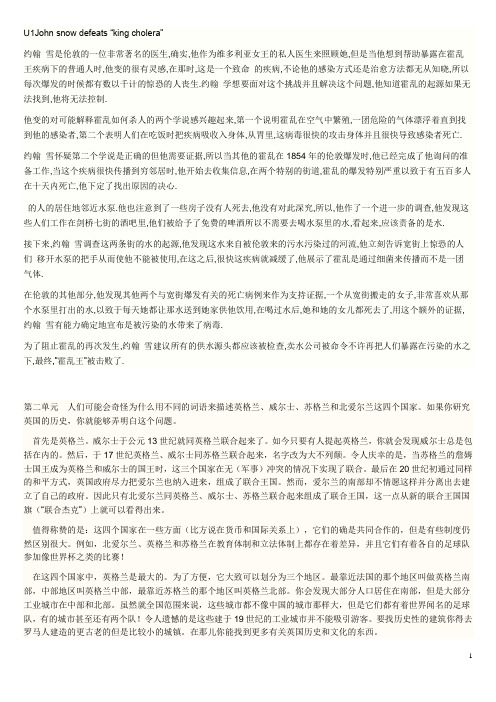
U1John snow defeats “king cholera”约翰雪是伦敦的一位非常著名的医生,确实,他作为维多利亚女王的私人医生来照顾她,但是当他想到帮助暴露在霍乱王疾病下的普通人时,他变的很有灵感,在那时,这是一个致命的疾病,不论他的感染方式还是治愈方法都无从知晓,所以每次爆发的时候都有数以千计的惊恐的人丧生.约翰学想要面对这个挑战并且解决这个问题,他知道霍乱的起源如果无法找到,他将无法控制.他变的对可能解释霍乱如何杀人的两个学说感兴趣起来,第一个说明霍乱在空气中繁殖,一团危险的气体漂浮着直到找到他的感染者,第二个表明人们在吃饭时把疾病吸收入身体,从胃里,这病毒很快的攻击身体并且很快导致感染者死亡.约翰雪怀疑第二个学说是正确的但他需要证据,所以当其他的霍乱在1854年的伦敦爆发时,他已经完成了他询问的准备工作,当这个疾病很快传播到穷邻居时,他开始去收集信息,在两个特别的街道,霍乱的爆发特别严重以致于有五百多人在十天内死亡,他下定了找出原因的决心.的人的居住地邻近水泵.他也注意到了一些房子没有人死去,他没有对此深究,所以,他作了一个进一步的调查,他发现这些人们工作在剑桥七街的酒吧里,他们被给予了免费的啤酒所以不需要去喝水泵里的水,看起来,应该责备的是水.接下来,约翰雪调查这两条街的水的起源,他发现这水来自被伦敦来的污水污染过的河流,他立刻告诉宽街上惊恐的人们移开水泵的把手从而使他不能被使用,在这之后,很快这疾病就减缓了,他展示了霍乱是通过细菌来传播而不是一团气体.在伦敦的其他部分,他发现其他两个与宽街爆发有关的死亡病例来作为支持证据,一个从宽街搬走的女子,非常喜欢从那个水泵里打出的水,以致于每天她都让那水送到她家供他饮用,在喝过水后,她和她的女儿都死去了,用这个额外的证据,约翰雪有能力确定地宣布是被污染的水带来了病毒.为了阻止霍乱的再次发生,约翰雪建议所有的供水源头都应该被检查,卖水公司被命令不许再把人们暴露在污染的水之下,最终,”霍乱王”被击败了.第二单元人们可能会奇怪为什么用不同的词语来描述英格兰、威尔士、苏格兰和北爱尔兰这四个国家。
高中英语必修五第一单元课文翻译
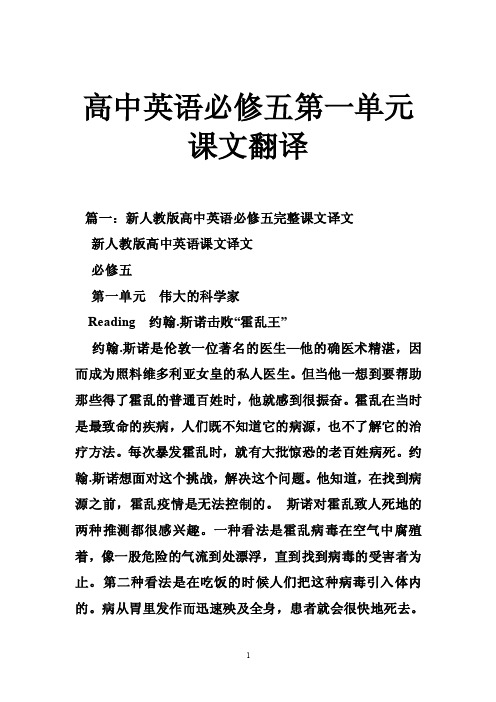
高中英语必修五第一单元课文翻译篇一:新人教版高中英语必修五完整课文译文新人教版高中英语课文译文必修五第一单元伟大的科学家Reading 约翰.斯诺击败“霍乱王”约翰.斯诺是伦敦一位著名的医生—他的确医术精湛,因而成为照料维多利亚女皇的私人医生。
但当他一想到要帮助那些得了霍乱的普通百姓时,他就感到很振奋。
霍乱在当时是最致命的疾病,人们既不知道它的病源,也不了解它的治疗方法。
每次暴发霍乱时,就有大批惊恐的老百姓病死。
约翰.斯诺想面对这个挑战,解决这个问题。
他知道,在找到病源之前,霍乱疫情是无法控制的。
斯诺对霍乱致人死地的两种推测都很感兴趣。
一种看法是霍乱病毒在空气中腐殖着,像一股危险的气流到处漂浮,直到找到病毒的受害者为止。
第二种看法是在吃饭的时候人们把这种病毒引入体内的。
病从胃里发作而迅速殃及全身,患者就会很快地死去。
斯诺推测第二种说法是正确的,但是他需要证据。
因此,在1854年伦敦再次暴发霍乱的时候,约翰.斯诺着手准备对此调研。
当霍乱在贫民区迅速蔓延的时候,约翰.斯诺就开始收集资料。
他发现特别在两条街道上霍乱流行的很严重,在10天之内就死去了500多人。
他决心要查明其原因。
首先,他在一张地图上标明了所有死者住过的地方。
这提供了一条说明霍乱起因的很有价值的线索。
许多死者是住在宽街的水泵附近(特别是这条街上16、37、38、40号)。
他发现有些住宅(如宽街上20号和21号以及剑桥上的8号和9号)却无人死亡。
他以前没预料到这种情况,所以他决定深入调查。
他发现,这些人都在剑桥街7号的酒馆里打工,而酒馆为他们免费提供啤酒喝,因此他们没有喝从宽街水泵抽上来的水。
看来水是罪魁祸首。
接下来,约翰.斯诺调查了这两条街的水源情况。
他发现,水是从河里来的,而河水被伦敦排出的脏水污染了。
他马上叫宽街上惊慌失措的老百姓拆掉水泵上的把手。
这样,水泵就用不成了。
不久,疫情就开始得到了缓解。
他证明了,霍乱是由病菌而不是由气团传播的。
【人教版】2019版高中英语必修5课文逐句翻译(Word版,15页,全站免费)
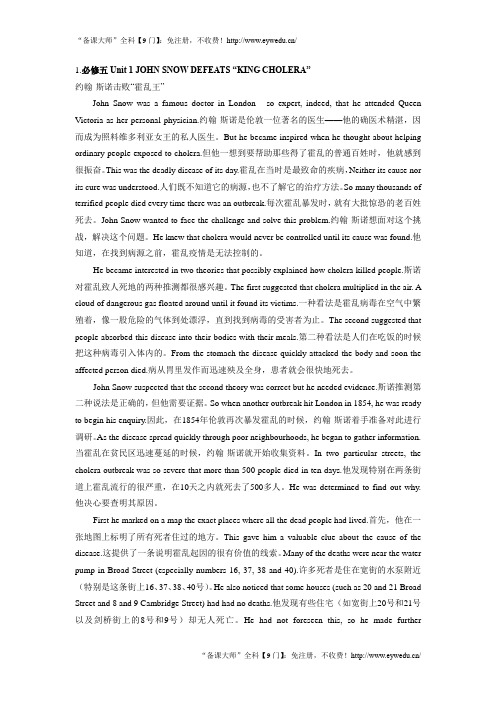
1.必修五Unit 1 JOHN SNOW DEFEATS “KING CHOLERA”约翰·斯诺击败“霍乱王”John Snow was a famous doctor in London - so expert, indeed, that he attended Queen Victoria as her personal physician.约翰·斯诺是伦敦一位著名的医生——他的确医术精湛,因而成为照料维多利亚女王的私人医生。
But he became inspired when he thought about helping ordinary people exposed to cholera.但他一想到要帮助那些得了霍乱的普通百姓时,他就感到很振奋。
This was the deadly disease of its day.霍乱在当时是最致命的疾病,Neither its cause nor its cure was understood.人们既不知道它的病源,也不了解它的治疗方法。
So many thousands of terrified people died every time there was an outbreak.每次霍乱暴发时,就有大批惊恐的老百姓死去。
John Snow wanted to face the challenge and solve this problem.约翰·斯诺想面对这个挑战,解决这个问题。
He knew that cholera would never be controlled until its cause was found.他知道,在找到病源之前,霍乱疫情是无法控制的。
He became interested in two theories that possibly explained how cholera killed people.斯诺对霍乱致人死地的两种推测都很感兴趣。
高中英语必修五课文及翻译
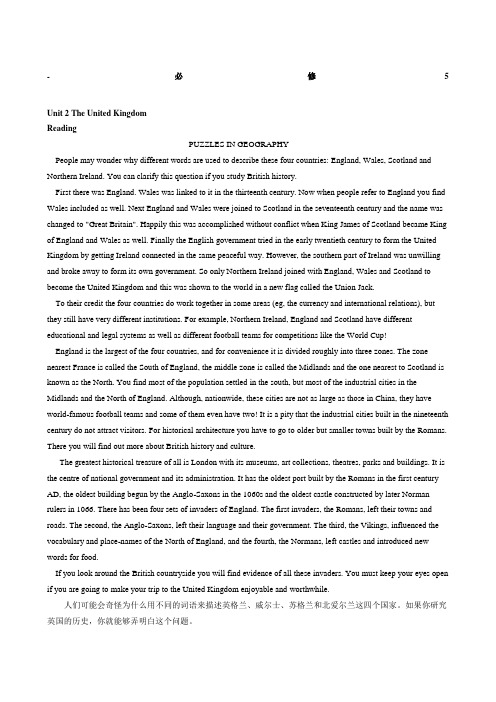
-必修 5Unit 2 The United KingdomReadingPUZZLES IN GEOGRAPHYPeople may wonder why different words are used to describe these four countries: England, Wales, Scotland and Northern Ireland. You can clarify this question if you study British history.First there was England. Wales was linked to it in the thirteenth century. Now when people refer to England you find Wales included as well. Next England and Wales were joined to Scotland in the seventeenth century and the name was changed to "Great Britain". Happily this was accomplished without conflict when King James of Scotland became King of England and Wales as well. Finally the English government tried in the early twentieth century to form the United Kingdom by getting Ireland connected in the same peaceful way. However, the southern part of Ireland was unwilling and broke away to form its own government. So only Northern Ireland joined with England, Wales and Scotland to become the United Kingdom and this was shown to the world in a new flag called the Union Jack.To their credit the four countries do work together in some areas (eg, the currency and international relations), but they still have very different institutions. For example, Northern Ireland, England and Scotland have different educational and legal systems as well as different football teams for competitions like the World Cup!England is the largest of the four countries, and for convenience it is divided roughly into three zones. The zone nearest France is called the South of England, the middle zone is called the Midlands and the one nearest to Scotland is known as the North. You find most of the population settled in the south, but most of the industrial cities in the Midlands and the North of England. Although, nationwide, these cities are not as large as those in China, they have world-famous football teams and some of them even have two! It is a pity that the industrial cities built in the nineteenth century do not attract visitors. For historical architecture you have to go to older but smaller towns built by the Romans. There you will find out more about British history and culture.The greatest historical treasure of all is London with its museums, art collections, theatres, parks and buildings. It is the centre of national government and its administration. It has the oldest port built by the Romans in the first century AD, the oldest building begun by the Anglo-Saxons in the 1060s and the oldest castle constructed by later Norman rulers in 1066. There has been four sets of invaders of England. The first invaders, the Romans, left their towns and roads. The second, the Anglo-Saxons, left their language and their government. The third, the Vikings, influenced the vocabulary and place-names of the North of England, and the fourth, the Normans, left castles and introduced new words for food.If you look around the British countryside you will find evidence of all these invaders. You must keep your eyes open if you are going to make your trip to the United Kingdom enjoyable and worthwhile.人们可能会奇怪为什么用不同的词语来描述英格兰、威尔士、苏格兰和北爱尔兰这四个国家。
新课标高中英语必修5 课文翻译及要点 unit1
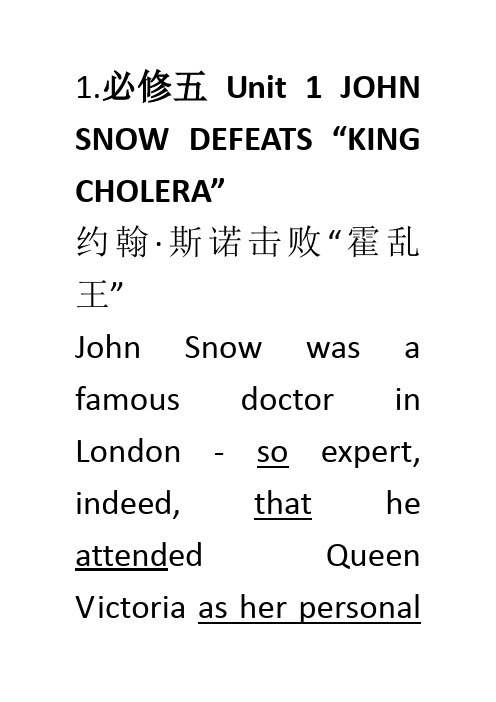
1.必修五Unit 1 JOHN SNOW DEFEATS “KING CHOLERA”约翰·斯诺击败“霍乱王”John Snow was a famous doctor in London - so expert, indeed, that he attended Queen Victoria as her personalphysician.约翰·斯诺是伦敦一位著名的医生——他的确医术精湛,因而成为照料维多利亚女王的私人医生。
But he became inspired when he thought about helping ordinary people exposed to cholera.但他一想到要帮助那些得了霍乱的普通百姓时,他就感到很振奋。
This was the deadly disease of its day.霍乱在当时是最致命的疾病,Neither its cause nor its cure was understood.人们既不知道它的病源,也不了解它的治疗方法。
So many thousands of terrified people diedevery time there was an outbreak.每次霍乱暴发时,就有大批惊恐的老百姓死去。
John Snow wanted to face the challenge and solve this problem.约翰·斯诺想面对这个挑战,解决这个问题。
He knew that cholera would never be controlled until itscause was found.他知道,在找到病源之前,霍乱疫情是无法控制的。
He became interested in two theories that possibly explained how cholera killed people.斯诺对霍乱致人死地的两种推测都很感兴趣。
- 1、下载文档前请自行甄别文档内容的完整性,平台不提供额外的编辑、内容补充、找答案等附加服务。
- 2、"仅部分预览"的文档,不可在线预览部分如存在完整性等问题,可反馈申请退款(可完整预览的文档不适用该条件!)。
- 3、如文档侵犯您的权益,请联系客服反馈,我们会尽快为您处理(人工客服工作时间:9:00-18:30)。
-必修 5
Unit 2 The United Kingdom
Reading
PUZZLES IN GEOGRAPHY
People may wonder why different words are used to describe these four countries: England, Wales, Scotland and Northern Ireland. You can clarify this question if you study British history.
First there was England. Wales was linked to it in the thirteenth century. Now when people refer to England you find Wales included as well. Next England and Wales were joined to Scotland in the seventeenth century and the name was changed to "Great Britain". Happily this was accomplished without conflict when King James of Scotland became King of England and Wales as well. Finally the English government tried in the early twentieth century to form the United Kingdom by getting Ireland connected in the same peaceful way. However, the southern part of Ireland was unwilling and broke away to form its own government. So only Northern Ireland joined with England, Wales and Scotland to become the United Kingdom and this was shown to the world in a new flag called the Union Jack.
To their credit the four countries do work together in some areas (eg, the currency and international relations), but they still have very different institutions. For example, Northern Ireland, England and Scotland have different educational and legal systems as well as different football teams for competitions like the World Cup!
England is the largest of the four countries, and for convenience it is divided roughly into three zones. The zone nearest France is called the South of England, the middle zone is called the Midlands and the one nearest to Scotland is known as the North. You find most of the population settled in the south, but most of the industrial cities in the Midlands and the North of England. Although, nationwide, these cities are not as large as those in China, they have world-famous football teams and some of them even have two! It is a pity that the industrial cities built in the nineteenth century do not attract visitors. For historical architecture you have to go to older but smaller towns built by the Romans. There you will find out more about British history and culture.
The greatest historical treasure of all is London with its museums, art collections, theatres, parks and buildings. It is the centre of national government and its administration. It has the oldest port built by the Romans in the first century AD, the oldest building begun by the Anglo-Saxons in the 1060s and the oldest castle constructed by later Norman rulers in 1066. There has been four sets of invaders of England. The first invaders, the Romans, left their towns and roads. The second, the Anglo-Saxons, left their language and their government. The third, the Vikings, influenced the vocabulary and place-names of the North of England, and the fourth, the Normans, left castles and introduced new words for food.
If you look around the British countryside you will find evidence of all these invaders. You must keep your eyes open if you are going to make your trip to the United Kingdom enjoyable and worthwhile.
人们可能会奇怪为什么用不同的词语来描述英格兰、威尔士、苏格兰和北爱尔兰这四个国家。
如果你研究英国的历史,你就能够弄明白这个问题。
首先是英格兰。
威尔士于公元13世纪就同英格兰联合起来了。
如今只要有人提起英格兰,你就会发现威尔士总是包
括在内的。
然后,于17世纪英格兰、威尔士同苏格兰联合起来,名字改为大不列颠。
令人庆幸的是,当苏格兰的詹姆士国王成为英格兰和威尔士的国王时,这三个国家在无(军事)冲突的情况下实现了联合。
最后在20世纪初通过同样的和平方式,英国政府尽力把爱尔兰也纳入进来,组成了联合王国。
然而,爱尔兰的南部却不情愿这样并分离出去建立了自己的政府。
因此只有北爱尔兰同英格兰、威尔士、苏格兰联合起来组成了联合王国,这一点从新的联合王国国旗(“联合杰克”)上就可以看得出来。
值得称赞的是:这四个国家在一些方面(比方说在货币和国际关系上),它们的确是共同合作的,但是有些制度仍然区别很大。
例如,北爱尔兰、英格兰和苏格兰在教育体制和立法体制上都存在着差异,并且它们有着各自的足球队参加像世界杯之类的比赛!
在这四个国家中,英格兰是最大的。
为了方便,它大致可以划分为三个地区。
最靠近法国的那个地区叫做英格兰南部,中部地区叫英格兰中部,最靠近苏格兰的那个地区叫英格兰北部。
你会发现大部分人口居住在南部,但是大部分工业城市在中部和北部。
虽然就全国范围来说,这些城市都不像中国的城市那样大,但是它们都有着世界闻名的足球
队,有的城市甚至还有两个队!令人遗憾的是这些建于19世纪的工业城市并不能吸引游客。
要找历史性的建筑你得去罗马人建造的更古老的但是比较小的城镇。
在那儿你能找到更多有关英国历史和文化的东西。
